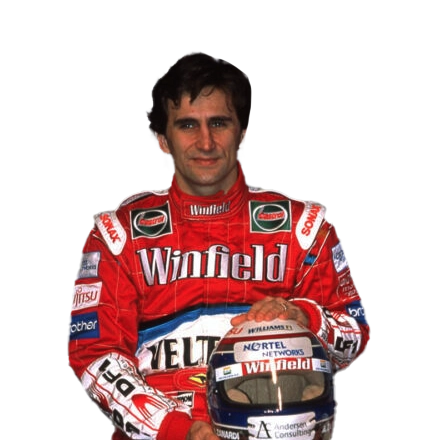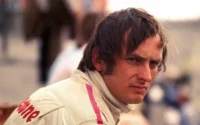Alex Zanardi is an Italian professional racing driver and Paralympic handcyclist whose life story is one of the most remarkable in F1 history and sports. A two-time CART Champion (1997, 1998) and a 15-time race winner, Zanardi’s career has spanned Formula One, American open-wheel racing, touring cars, and world-class Paralympic competition. His ability to reinvent himself after a life-altering crash in 2001 has made him both a motorsport legend and an icon of strength.
| Nationality | Italian |
|---|---|
| Born | Alessandro Zanardi 23 October 1966 (age 59) Bologna, Italy |
Born in Bologna, Italy, on 23 October 1966, Alex grew up in nearby Castel Maggiore after the family moved there when he was four. His sister Cristina was a gifted swimmer before tragically dying in a car accident in 1979, a loss that profoundly shaped his outlook on life.
At 13, Zanardi began racing karts, ingeniously building his first kart himself using the wheels of a dustbin and pipes from his father’s work. His mechanical creativity would later become one of his trademarks.
In 1988, he entered the Italian Formula 3 Championship, finishing as high as fifth. The following year, he took two poles and three podiums despite engine difficulties caused by his team’s switch to unleaded fuel. By 1991, Zanardi had moved to Formula 3000 with the Il Barone Rampante team, winning his debut race and two more victories that season to finish runner-up in the championship, his first major breakthrough.
Formula One: 1991–1994
Zanardi’s Formula One debut came with Jordan in 1991, replacing Roberto Moreno for the final three races. He finished twice in ninth place, an impressive start that led to guest drives with Minardi in 1992. After testing for Benetton, he joined Lotus for the 1993 season, a move he later admitted might have cost him a chance at a future Benetton seat alongside Michael Schumacher.
Despite the team’s struggles, Zanardi’s technical feedback proved crucial to Lotus’s development of its active suspension system. He earned his sole F1 point with a sixth-place finish at the 1993 Brazilian Grand Prix.
That year brought setbacks too, an accident with a car while cycling left him with multiple fractures, and a heavy crash during practice for the 1993 Belgian Grand Prix ended his season early. In 1994, he returned as Lotus’s test driver and later replaced Pedro Lamy mid-season, though the once-proud team was nearing collapse. Zanardi’s year ended without points, and Lotus folded soon after.
Determined to keep racing, he dabbled in sports cars, competing in Porsche Supercup events and endurance races at Donington Park and Silverstone.
ART Championship Series: 1996–1998
In 1995, Zanardi crossed the Atlantic to seek a new challenge in America’s CART Championship. After a test at Homestead with Chip Ganassi Racing, he signed on — despite team engineer Mo Nunn’s warning that “Italian drivers make too many mistakes.” Zanardi would soon prove him spectacularly wrong.
He quickly became a fan favourite, taking pole in just his second race and three wins in his rookie season, earning third in the standings and the Rookie of the Year title.
His final race of 1996 at Laguna Seca produced one of motorsport’s most iconic moments — “The Pass” — a daring overtake on Bryan Herta at the Corkscrew corner that has since become racing legend.
In 1997, Zanardi dominated with five wins and his first championship. The following year he was even more untouchable: seven wins, fifteen podiums, and a second straight CART title. His celebratory post-race “doughnuts” — spinning the car in tight circles of smoke and rubber — became a signature move later copied by drivers worldwide.
Return to Formula One: 1999
Zanardi’s American success caught the attention of Sir Frank Williams, who signed him to drive for the Williams F1 team in 1999. Despite flashes of speed — including out-qualifying Schumacher at Monaco — the season was plagued by mechanical failures, setup issues, and sheer misfortune. His best finish was seventh at Monza, but by the season’s end, team and driver parted ways, ending his Formula One career for good.
CART return and Lausitzring crash: 2001
After sitting out the 2000 season, Zanardi returned to CART in 2001 with Mo Nunn Racing. Midway through a difficult year, he produced a string of competitive performances, including a fourth-place finish in Toronto.
Then came tragedy. On 15 September 2001, during the American Memorial 500 at the EuroSpeedway Lausitz, Zanardi spun while rejoining the track after a pit stop and was struck broadside by another car. The impact severed both his legs — one at and one above the knee — and he lost nearly 75% of his blood. Miraculously, emergency crews saved his life.
Zanardi later said, “When I woke up without legs, I looked at the half that was left, not the half that was lost.” It became the defining philosophy of his comeback.
Post-amputation racing career: 2003–2019
Refusing to retire, Zanardi designed and built his own prosthetic legs, specifically engineered for driving. In 2003, he completed the 13 laps he never finished at Lausitzring, his pace quick enough to qualify fifth for the actual race.
He made his full-time comeback in the European Touring Car Championship in 2004, driving a hand-controlled BMW. When the series evolved into the World Touring Car Championship (WTCC), Zanardi scored four victories between 2005 and 2009 and won the 2005 Italian Superturismo title with eight wins.
He continued to test the limits: driving a Formula One car for BMW Sauber in 2006, developing his own line of racing karts with CRG (used by future F1 driver Nyck de Vries), and later competing in GT and DTM events. His 2019 appearance at the 24 Hours of Daytona, using a specially adapted BMW M8 GTE, marked his return to American racing nearly two decades after his crash.
The Alex Zanardi Edition NSX
In recognition of his back-to-back CART titles, Honda released the Alex Zanardi Edition Acura NSX in 1999 — a lightweight, track-focused version of the supercar. Only 51 were made, all painted in New Formula Red to match his Ganassi car. The model remains one of the most collectable NSXs ever produced.
Handcycling and triathlon career: 2007–2018
Never content to stop competing, Zanardi turned to handcycling — a form of Paralympic cycling — with characteristic zeal. After finishing fourth in the 2007 New York City Marathon just weeks after taking up the sport, he went on to win multiple international events and declared his goal of representing Italy at the 2012 Paralympics.
He won his first international medal — silver in the H4 time trial — at the 2011 UCI World Championships, and a year later at the London 2012 Paralympics, he claimed two golds (time trial and road race) and a silver (team relay). His handbike, built by Dallara, was a technical marvel.
Zanardi added more medals at the Rio 2016 Paralympics (two golds, one silver) and went on to shatter the Ironman world record for athletes with disabilities in 2018 with a time of 8:26:06 — ranking fifth overall in the entire race. His endurance achievements rivalled his racing fame.
2020 accident and recovery
On 19 June 2020, while competing in the Obiettivo tricolore handcycling race near Siena, Zanardi lost control on a descent and collided with a truck. He suffered severe cranial and facial trauma and underwent multiple surgeries.
Despite the gravity of his injuries, Zanardi once again showed extraordinary resilience. Over the following months, he gradually regained vision, hearing, and speech, eventually returning home in December 2021 — 18 months after the crash — to continue rehabilitation.
In 2022, he was briefly hospitalised again after a house fire caused by faulty solar panels damaged his medical equipment, but he recovered and was discharged after 76 days.
Personal life
Zanardi has been married to Daniela Manni since 1996, and they have one son, Niccolò, born in 1998. He has co-written two autobiographies — My Story and My Sweetest Victory — and been the subject of numerous documentaries and books, including those by CART medical director Dr. Steve Olvey.
His trophy cabinet includes the Autosport Gregor Grant Award (1998, 2003), the Laureus World Sports Award for Comeback of the Year (2005), and the Gazzetta Legend Award (2015). He was inducted into the Motorsports Hall of Fame of America in 2013 and the Long Beach Motorsports Walk of Fame in 2022.
Alex Zanardi’s career defies easy categorisation — part racer, part inventor, part philosopher. Through triumph and tragedy, he has redefined what determination means, forever earning his place as one of the most inspiring figures in sport.
Explore Alex Zanardi’s F1 legacy alongside other top drivers who never claimed a Grand Prix win in our feature examining the greatest winless talents.
Alex Zanardi Formula One World Championship Career
| F1 Career | 2000–2001 |
|---|---|
| Teams | Jordan, Minardi, Lotus, Williams |
| Entries | 44 (41 Starts) |
| Championships | 0 |
| Wins | 0 |
| Podiums | 0 |
| Career points | 1 |
| Pole positions | 0 |
| Fastest laps | 0 |
| First entry | 1991 Spanish Grand Prix |
| Last entry | 1999 Japanese Grand Prix |
Alex Zanardi Teammates
| 6 drivers | Involvement | First Year | Last Year |
|---|---|---|---|
| Andrea de Cesaris | 3 | 1991 | |
| Gianni Morbidelli | 3 | 1992 | |
| Johnny Herbert | 19 | 1993 | 1994 |
| Eric Bernard | 1 | 1994 | |
| Mika Salo | 2 | 1994 | |
| Ralf Schumacher | 16 | 1999 |
Alex Zanardi Complete Formula One Results
| Year | Entrant | Chassis | Engine | 1 | 2 | 3 | 4 | 5 | 6 | 7 | 8 | 9 | 10 | 11 | 12 | 13 | 14 | 15 | 16 | WDC | Pts |
|---|---|---|---|---|---|---|---|---|---|---|---|---|---|---|---|---|---|---|---|---|---|
| 1991 | Team 7UP Jordan | Jordan 191 | Ford HBA4 3.5 V8 | USA | BRA | SMR | MON | CAN | MEX | FRA | GBR | GER | HUN | BEL | ITA | POR | ESP 9 | JPN Ret | AUS 9 | NC | 0 |
| 1992 | Minardi Team | Minardi M192 | Lamborghini 3512 3.5 V12 | RSA | MEX | BRA | ESP | SMR | MON | CAN | FRA | GBR DNQ | GER Ret | HUN DNQ | BEL | ITA | POR | JPN | AUS | NC | 0 |
| 1993 | Team Lotus | Lotus 107B | Ford HBD6 3.5 V8 | RSA Ret | BRA 6 | EUR 8 | SMR Ret | ESP 14 † | MON 7 | CAN 11 | FRA Ret | GBR Ret | GER Ret | HUN Ret | BEL DNQ | ITA | POR | JPN | AUS | 20th | 1 |
| 1994 | Team Lotus | Lotus 107C | Mugen Honda MF-351 HC 3.5 | BRA | PAC | SMR | MON | ESP 9 | CAN 15 | NC | 0 | ||||||||||
| Lotus 109 | Mugen Honda MF-351 HC 3.5 | FRA Ret | GBR Ret | GER Ret | HUN 13 | BEL | ITA Ret | POR | EUR 16 | JPN 13 | AUS Ret | ||||||||||
| 1999 | Winfield Williams | Williams FW21 | Supertec FB01 3.0 V10 | AUS Ret | BRA Ret | SMR 11 † | MON 8 | SPA Ret | CAN Ret | FRA Ret | GBR 11 | AUT Ret | GER Ret | HUN Ret | BEL 8 | ITA 7 | EUR Ret | MAL 10 | JPN Ret | NC | 0 |







